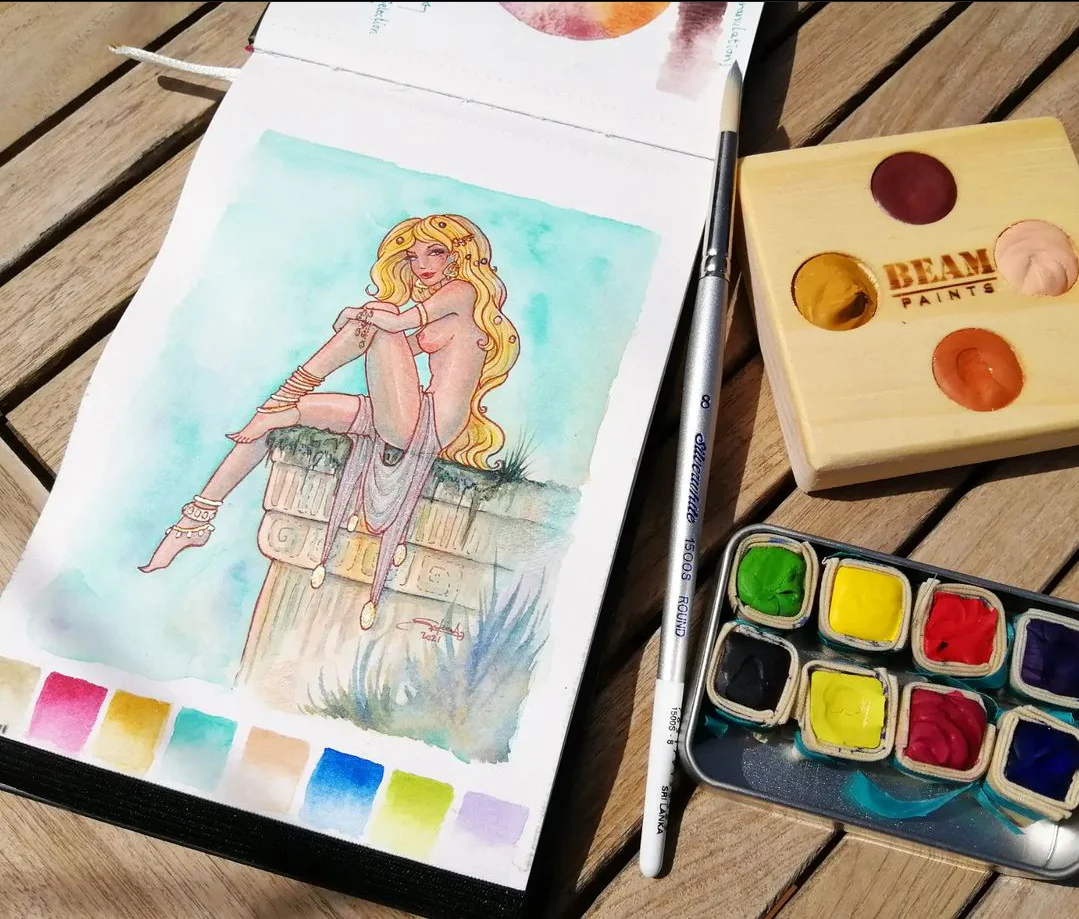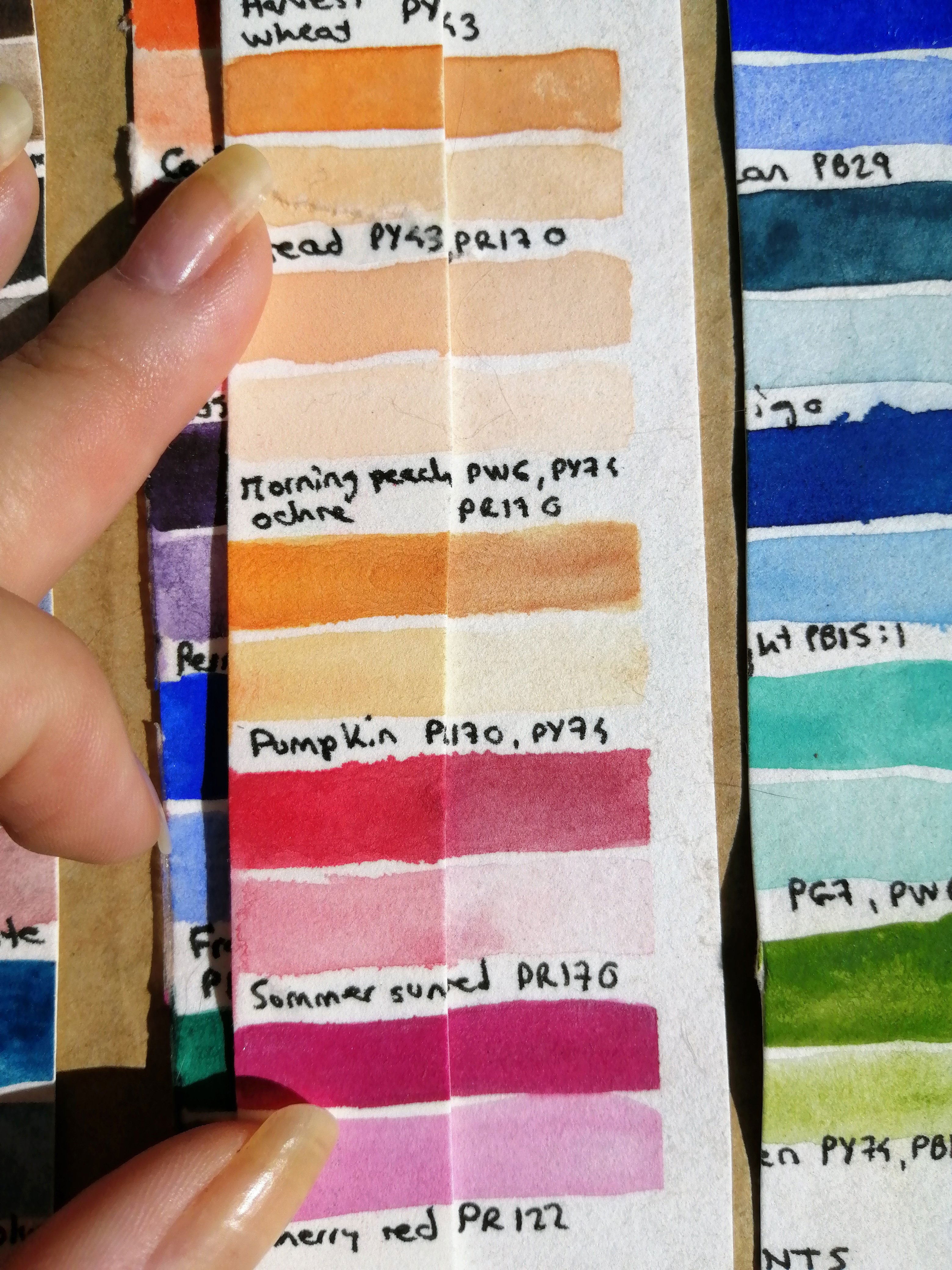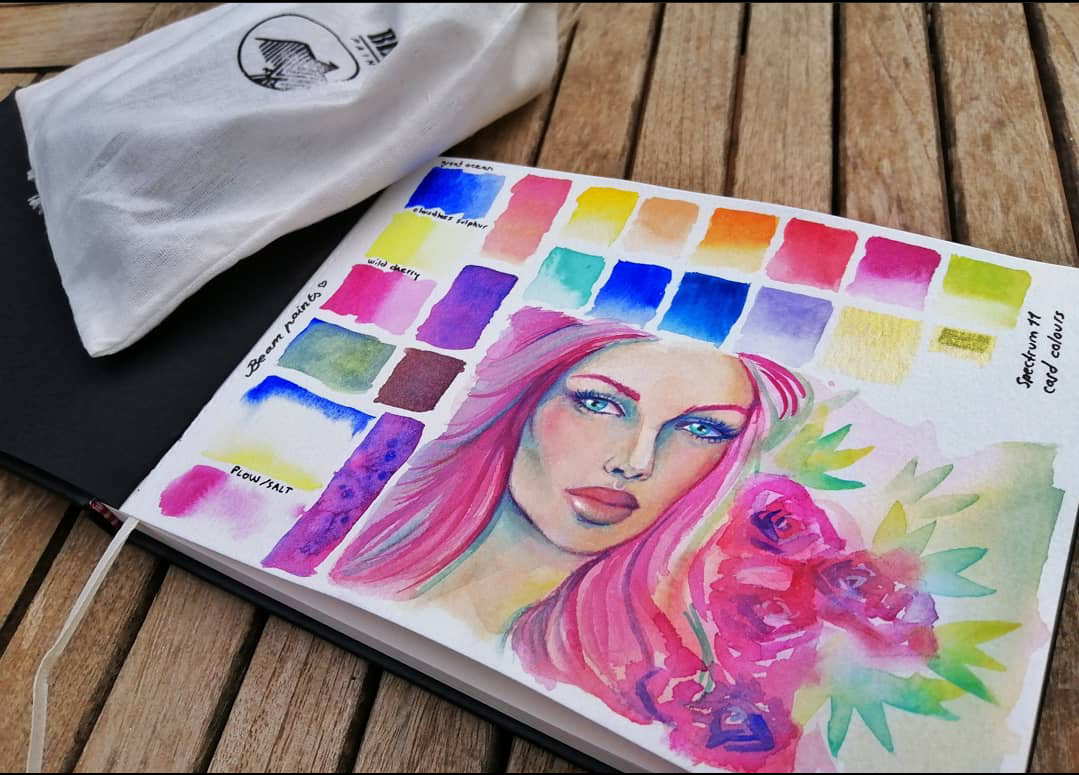Lightfastness tests update: Beam Paints!
Hello and welcome to this blog entry where I talk about some of my ongoing watercolour lightfastness tests in-depth.
Today we're going to take a look at the Beam Paints watercolour swatches, pigment information included and some pigment nerding towards the end.
These tests were put up to receive daily sunlight on 24th June 2021 and the photos on this blog entry were taken on October 9th 2021.
Please keep in mind that the paints tested from the brand Beam Paints were bought in 2021, therefore this is the old discontinued formula. As of today, 23th October 2023, the artisan, paintmaker and Beam Paints founder Anong Migwans Beam has informed me that their current paintstones have a different formulation since the brand has changed pigment suppliers for the two pigments most affected by the sun (PY74 and PR170).
So it's been roughly 3 months of aggressive sun exposure on my roof top. Another important factor to keep in mind is the aggressive aspect of my tests, they're quite extreme.

What are Beam Paints?
Beam Paints is a Canadian based indigenous small business that creates plastic free art materials. According to their website, their paints are lightfast pigments, tree sap, Manitoulin honey, and gum Arabic blended together to create a handmade saturated colour that is a joy to paint with.
All I can say is that they're indeed a joy to paint with. The paints are formulated in a way that they reactivate quickly, flow naturally on wet paper and leave a delicious scent all over your room.
If you want to know more about this small business, check out their page:
Why fugitive paints shouldn't be underestimated
Beam Paints have some fugitive colours in their collection that aren't good for archival work. This is not an issue for everyone, what doesn't work for an artist may work for a different one. Plus the company also offers a lot of stable and lightfast paints that won't be a problem for those who sell their original art or hang it on walls.
Some pigments happen to be fugitive and that doesn't mean they're low quality. Lightfastness (or the lack of it) is a pigment property that depends on the chemical structure of each pigment's molecule. Some fine pigments like PB27 are fugitive because that's how the particle is built.
There are a lot of interesting things we can do with fugitive paints: sketchbook art, practices, art we're going to scan and sell as prints instead of originals, experimental art that changes and shifts hues overtime etc.

I've painted some gorgeous illustrations with these paints on my sketchbooks, scanned them and made sure they're protected with a fixing spray for watercolor art.
Don't let pigment properties stop you!
Should we care about lightfastness then?
Of course, we should always know our pigments. Depending on your needs and preferences as an artist, you may prefer to buy only archival paints that won't fade over time. In case that's what you want, I suggest you do some research and pay attention to pigment numbers. Doing your own lightfastness tests is also a good idea in these cases.
The actual tests
On the picture below you can see how my lightfastness tests work: for each colour I lay down two swatches of paint, one is in masstone and the other one below is diluted.

Please take sometime to review the image above as it contains all the information about colour changes observed in Beam Paints.
If you want to read a longer in-depth explanation, keep going! Pigment nerding below! 💪🏻
Now the colours that faded the most and started fading quicker were Summer Sun Red PR170 and Mayan Indigo. I wasn't surprised about the indigo as genuine Mayan pigments aren't lightfast, so I expected it to fade. Seeing it actually change was an unmistakable indicator that it's genuine Mayan indigo pigment. The real deal.
Their beautiful primary red Summer Sun Red PR170 is fugitive so any convenience colour containing PR170 will show changes.

In the photo above you can see how their convenience colours in the orange range (Pumpkin PR170+PY74, Bread PY43+PR170, Morning Peach Ocher PY74+PR170+PW6) show some fading because they all contain either PY74, PR170 or both.
Their Cherry Red PR122 is an extremely lightfast magenta that did an amazing job maintaining its vibrancy in such harsh conditions.

Fall Poplar Yellow PY74 faded after 2-3 months of harsh sun exposure. The diluted watercolour swatch disappeared from the paper. They offer stable and lightfast yellows such as their gorgeous Cloudless Sulfur PY3 and the ochre Harvest Bread PY43.
The pigment PY74 being fugitive affects the convenience greens like Spring Green (PY74+PB15:1) seen below.

Beam Paints also offer a wide range of stable green such as Robin's Egg, Salish Sea, Boreal etc.
Other fugitive colours that have faded are their pastel paintstone Lavender (PV23+PW6) and the previously mentioned Mayan Indigo (as expected from a genuine Indigo).


They seem to be using a fugitive version of the often problematic pigment PV23 for their Lavender (PV23+PW6), this is often hard to avoid and it completely depends on pigment manufacturer. Again, it absolutely doesn't mean paint quality is low.
It's important to take into account they offer more colours in their shop than those shown in this blog post.
I made two useful lists for my fellow artists: one lists the wide range of stable/lightfast paints available in their collection while the second list collects the fugitive colours. This list is, however, outdated and could benefit from a 2023 revision (it may still be useful for those who got Beam Paints before 2022).
The criteria I used to carefully gather all the fugitive and stable colours into two lists was whether or not they contain the pigments that fade, meaning PR170, PY74, PV23, and PB27 (Prussian blue, a fugitive blue that will always fade no matter the brand).
I left out all the mica and lakebed gathered colours (yes, they make paints from soil!!) as I can't state if they're lightfast without testing them. I don't want to mislead anyone.
Again, it's entirely up to you whether you want to paint with only lightfast watercolours or you don't mind the fugitive pigments. I personally love to collect all kinds of pigments and paint with them.
Personally, I suggest you try out Beam Paints. I very much enjoy to paint with their beautifully wrapped paintstones and their scent transports me to the forests. Knowing that I'm working with a handmade plastic-free product fills me with joy.
Beam Paints lightfast paintstones:
Wiigwaasmin’aande-Cherry Magenta: PR122
Mshikenh Misud-Turtle Belly: PR122, PY3
Mars Violet: PR101
Chiigbii Giinii’aande-Beach Rose: PR122, PW6
Ginii Aande-Wild Rose: PR122, PW6
Harvest Wheat: PY43Doodooshabo’aande-Cream: PW6
Cloudless Sulphur-hansa light: PY3
Salish Sea: PG7
Mtigwaaking-Boreal: PG17
Robins Egg Blue: PG7, PW6
Lake Huron Teal: PG7
Geygaa Naakshek'aande-Almost night: PB15:1
Gchigaaming’aande-Great Ocean: PB29
Giizhgaande-Sky Blue: PB15:1, PW6
Mkwum’aande-Ice Blue: PB29, PW6
Zhoomin’aande-Grape PV15
Zhiibiigun’Aazhbik-Slate ( society of French ochres earth)
Zhiibiigun’atik-Graphite
Awun (fog)-Grey Ocher (Society of French Ochres earth)
Mkdeh’aande-Mars Black: PBK11
Limestone White: PW6
Beam Paints fugitive paintstones:
Neebin Giizis’aande-Summer Sun Red: PR170
Kosmaan’aande-Pumpkin: PY74, PR170
Qwejigun-Bread: PY43, PR170
Kizheb’aande-Morning Peach: PY74, PR170, PW6
Dwaagi’Azaadibuk’aande-Fall poplar yellow: PY74
Zhaawbmide-Butter: PY74, PW6
Memmemgwanh Waaskoneh’aande -Milkweed (butterfly flower): PB15:1, PY74, PW6
Ziigwun’aande-Spring green: PB15:1, PY74
Shingwauk’aande-Pine: PB15:1, PY74
Prussian Blue: PB27
Waaskonense-Violet (small flower): PB15:1, PV23
Miin’aande Azhbikoong (blueberry mountain): PV23
Gaatchi Waaskonense-Lavender (tiny small flower): PV23, PW6
Chi’ngwaankwat (Very Cloudy)-Payne’s Grey: PB29, PY43, PR170
Ngwanquat (Cloud)-Ultra grey: PB29, PY43, PR170, PW6
I hope you find this blog entry useful and informative, please let me know what you think in the comments, have you tried Beam Paints?
